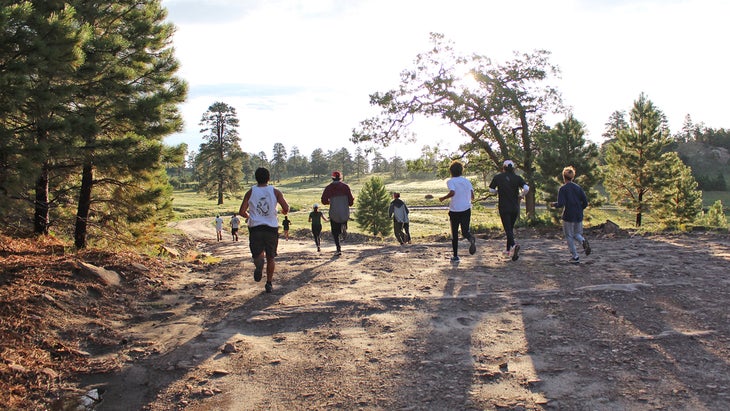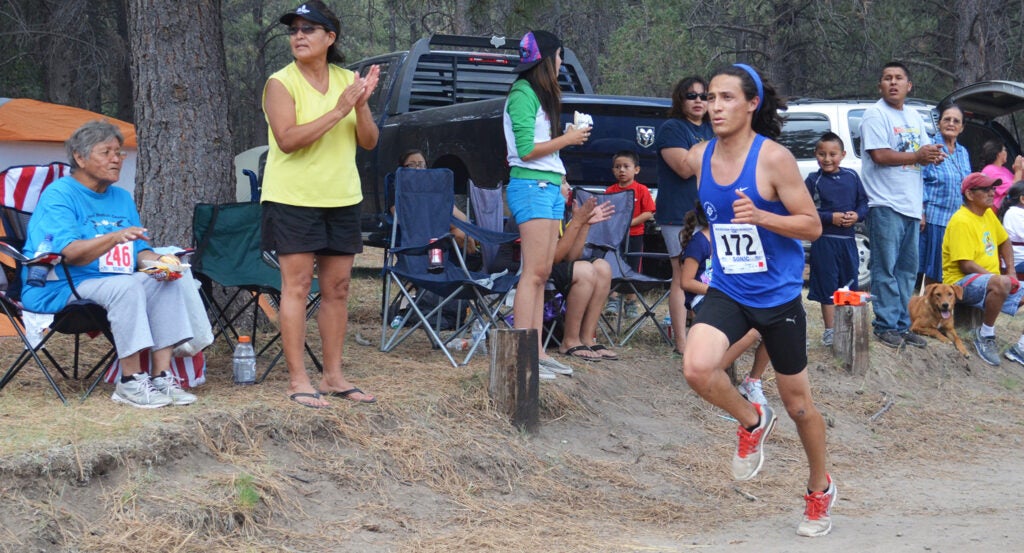No products in the cart.
Outdoor Adventure
Every Run Is a Gift
The voice and drum of Larry Spotted Crow Mann rang clear as the sun came up in Hopkington, MA on October 11, 2021—Indigenous Peoples’ Day. A member of the Nipmuc Nation, the local elder was invited by the Boston Athletic Association to offer words before the start of their prized Marathon, being run in the fall for the first, and likely only, time in history. His song was offered as a prayer for the safety of runners, spectators, and race officials traversing lands that he and his ancestors have called home for time immemorial. Patti Dillon, the first American (and Native American) woman to break 2:30 in the marathon and three-time Boston runner-up, fired the starter’s pistol for the elite field a few hours later.
Though dozens of media outlets highlighted the culture, history, and color added to race festivities by Indigenous runners, artists and activists eager to represent on their holiday, the subtitle of one New York Times’ story lamented a collective loss of innocence and pined for the return of the traditional spring “Patriot’s Day.” “The focus on Indigenous peoples,” stated the Times, “added an unusual, somber note to marathon weekend, in the heart of a region that has long unreservedly celebrated its colonial history.”
Despite the harsh truths drummed up by “land acknowledgments,” more and more race directors across North America are choosing to recognize the original stewards of the Lands that host their events. Mega-popular races like the Western States Endurance Run have added acknowledgments to their opening ceremonies. And even the New York City Marathon invited Indigenous Peoples from various Native Nations to honor the Lenape at their opening ceremony last month. Although I wasn’t there to hear the words offered by Ramapough Munsee (Lenape) elder, Chief Perry, I have absolute confidence that like Spotted Crow Mann’s, they focused on wishing race participants fleet feet and safety—not pangs of guilt—as they crisscrossed the five boroughs.
Blessings and Prayers
It may come as a surprise to some that “land acknowledgments” were commonplace at many Native-led running events long before the advent of “Justice, Equity, Diversity & Inclusion” (JEDI) in mainstream American culture. And no matter how local, regional and national politics play out, they will continue to be protocol across “Indian Country.” Typically offered by a local elder, these words are received by participants before the start of a run as “blessings,” “invocations,” or simply “prayers.” In many cases, visitors from neighboring Tribes do not fully comprehend what is being said because they do not speak the same language as the person praying. But they remove their caps and bow their heads in thanks for the opportunity to glide over the course set before them.
As non-Indigenous race directors grapple with the question of whether or not to include a land acknowledgment as part of their events, I encourage them to engage with Rising Hearts’ “Running On Native Lands Initiative” for further perspective and practical strategies for researching and organizing substantive recognition of the First Peoples of the Land. You will also find suggestions on how to be more inclusive of Indigenous Peoples in the future, ways that go beyond checking the box. Spoiler alert: to conduct a “land acknowledgment” that doesn’t come across as performative, you’ll need to engage with and be prepared to compensate Indigenous Peoples. And take note, if local Indigenous community members want to honor the Land in a manner different from what you imagined, listen, and try not to project “Tribal” identities from other Landscapes onto your collaborators.
The Simple Act of Feeling Thankful
Beyond formal “land acknowledgments” organized by race directors, however, I would like to encourage fellow runners (and walkers) to develop their own rituals to give thanks to the Earth each time they lace up. Though I am uniquely privileged to maintain a connection with my Indigenous Land, language, and kin, my capacity to appreciate those gifts is something I have had to cultivate. Running has been my primary tool throughout this lifelong process—a tool those from any cultural heritage can employ.
Without a sense of responsibility to monitor, safeguard and educate myself about the history of my running paths, I suspect my relationship with the sport would feel rather empty by now. Thinking back to what many might consider the peak of my running career—competing at the Division I college level—I shudder to remember how many workouts my teammates and I hammered through, fixated on our watches. During these runs, the Land was nothing more to me than an obstacle challenging my performance, simply something to be conquered.
Even during those uber-competitive days, however, I found healing from the Earth through running. Quiet, lonely runs out from my dorm room into Central Park helped me shake off worries about exams and nagging injuries. And although I was crisscrossing one of the most-manipulated Landscapes in human history—Manhattan—I was able to smell the flowers and feel a renewed gratefulness to be alive. I now understand that this feeling of gratitude was a gift from the Land, and the simple act of feeling thankful was a “land acknowledgment.”
Running also offered me an opportunity to reacquaint myself with the Land and culture I grew up with. Working as a summer camp facilitator for Wings of America, a not-for-profit that has encouraged running amongst Native youth since 1988, I was able to revisit places of my childhood with a new sense of purpose. Instead of getting off the reservation, I focused on relaying my experiences and celebrating the many achievements of Indigenous runners. If there is one thing my affiliation with the organization has taught me, it is that no matter how fast, far, or fiercely you intend to move on any given day, you should always take a moment to think of others and give thanks for your surroundings and abilities.

Today, as I traverse many of the same trails I grew up using, I also take pride in remembering the intermittent streams that have not run for years and the soft dirt trails that once weaved through lots now covered in houses. But I am not special. It’s safe to say that most religious runners and walkers can recount details about their environment that others never stepped out to observe. These memories are valuable testimonies of changes that affect us all. As a child of the desert, my own “land acknowledgments” have become focused on water, with hope that there will be enough for us all moving forward.
Engaging with the Land
On a less anxious note, I would like to remind readers that enjoying the fruit from a tree along your running or walking route is also a form of “land acknowledgment.” I’ve rarely felt more thankful to be alive than after methodically dissecting handfuls of apricots with my teeth in the midst of a late summer run. We can all find inspiration in the idea that our knowledge of time-sensitive resources like fruiting trees pales in comparison to that of our ancestors. But those skills are still worth honing today.
Whether or not race directors agree on the importance of formal land acknowledgments, I am hopeful that the larger running community will continue to reflect on our relationship with the Land and further engage with its history. Aside from an appreciation for life itself, this commitment will equip us with the knowledge, conviction, and vocabulary we need to defend our favorite routes for future generations.
Dustin Martin was born on the Navajo Nation in Chinle, AZ. He spent his early years in and around Gallup, NM, and attended high school in Albuquerque. After graduating with a bachelor’s in anthropology from Columbia University in 2011, he returned home to work for Wings of America. Today, he serves as the organization’s Executive Director. Apart from continuing to provide access to new levels of competition and education to Native students through running, he is focused on expanding the organization’s capacity to transmit Indigenous running history and instigate movement amongst youth with no interest in racing.
Please join us in supporting Wings of America so that they can continue to provide Native students with education, inspiration, and access to running opportunities.
Source link

